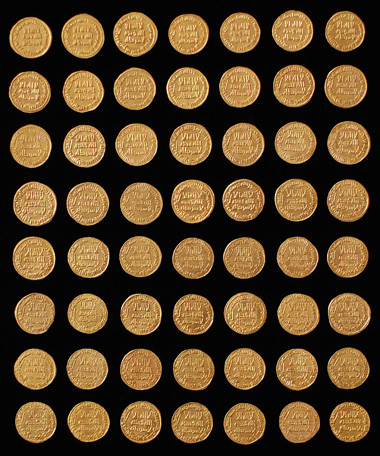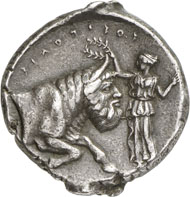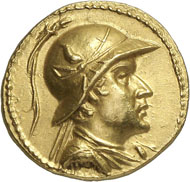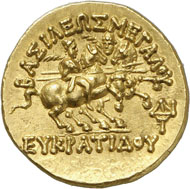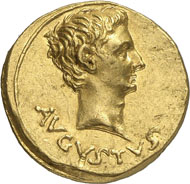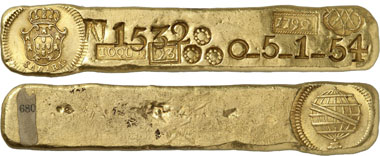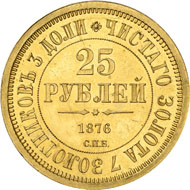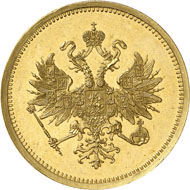26-11-2012 – 27-11-2012
Auction sale 7
1.3 Million Swiss Francs For a Complete Collection of the First Islamic Gold Dinars
There was great applause when lot number 439 was finally knocked down on November 27, 2012 at the ritzy Hotel Beau-Rivage in Geneva. Why? Because this most spectacular of the impressive lots from the Islamic coins section brought in an astounding 1.3 million Swiss francs. It also helped mark a turning point – with this, Geneva effectively superseded not only Zurich as the centre of exclusive coin trading, but also London, which for decades had been considered the hub of Islamic numismatics.
Collection of 56 Umayyad dinars from AH 77 to 132 (696-750). Of particular note is the extremely rare dinar of Abd al-Malik from the year AH 77. This is quite arguably the finest issue of this historical series, which is of great religious-historical significance. Estimate: 400,000 CHF. Hammer Price: 1,300,000 CHF.
It was a very special multiple lot that started the Numismatica Genevensis Islamic coins section: In the year 77 after the Hijra, the year 696 according to the European calendar, Abd al-Malik bin Marwan (AH 65-86; 685-705 AD) decided to mint a new type of coin. He abandoned the Byzantine prototypes and opted instead for a purely Islamic message for his coins to proclaim for the future. “There is no God but God. He is the one and only, without equal.” Even today, Muslims still avow their faith with almost the same words. And it is this profession of faith alone that occupies the place on the obverse, which, on Byzantine coins, was normally reserved for emperors. The inscription is taken from Verse 33 of the 9th Surah: “Muhammad is the Messenger of God, whom he has sent with the guidance and the religion of truth, that he may prevail over all other religions.” The reverse is also dominated by a message from the holy Quran; Surah 112, Verse 1-3: “He is Allah, the one, the absolute God. He begets not, nor was he begotten.” The inscription reads: “In the name of God, this dinar was minted in the year 77.”
Abd al-Malik had introduced a coin whose stability in both weight and gold content was to make it the most popular trade coin of the Middle Ages. The gold dinar became the money of choice not just in the Islamic countries, but everywhere where luxury goods from the Orient were traded.
In this, their 7th auction, Numismatica Genevensis was able to offer a complete ensemble of all years of the earliest strictly Islamic gold coins, including all rarities of this series and with every single piece in outstanding condition. With a hammer price of 1.3 million francs as opposed to its overall estimate of 400,000, this lot turned out to be auction’s most expensive.
Auction Numismatica Genevensis 7 was a record auction. The following are but a few examples. The undated dinar of Abu al-Hayyay Yusuf (AH 794-795; 1391-1392) from Granada in extremely fine climbed from its estimate of 50,000 all the way to 140,000 francs. An extremely fine 5 toman minted in the Iranian city of Tabriz in AH 1233 (1817-1818) sold for a “mere” 100,000 francs.
21: Gela (Sicily). Tetradrachm, around 440-430. Jenkins 371, 8 and Tf. 48 (this specimen). Regling 550 (this specimen). From the Gotha, R. Käppeli 49 and Herbert Cahn Collections. Showpiece. Estimate: 15,000 CHF. Hammer price: 160,000 CHF.
Most of the record prices were realized by the Celtic, Greek and Roman coins in the ancient coins division. A tetradrachm from Gela of the finest style and in the best of conditions with an impeccable pedigree climbed from its estimate of 15,000 to an unbelievable 160,000 francs.
286: Eucratides (Bactria), 171-135. Gold stater, Merv. Mitch. Type 176var. Oikonomedes (1968), Group B. Rare and extremely fine. Estimate: 100,000 CHF. Hammer price: 170,000 CHF.
A gold stater of Eucratides sold for an even more impressive 170,000 francs!
Two Celtic coins with all the charm of modern abstraction also had impressive showings: An extremely rare Aulerci gold stater changed hands for 100,000 francs, and a gold stater of the Parisii, quite arguably from the most attractive die ever created by a Celtic die-cutter, went for a very substantial 140,000 francs.
321: Augustus, 27 BC-14 AD. Aureus, 19-18, Pergamum. RIC cf. 82, 511var. Calicó 157 (same dies). Rare. Extremely fine. Estimate: 75,000 CHF. Hammer price: 240,000 CHF.
Let’s just quickly mention another three hammer prices, here from the Roman division: A rare aureus of Augustus that features the Sphinx on the reverse went for an amazing 240,000 francs, a perfect sestertius of Caligula depicting the historically interesting sacrificial scene, quite possibly the best known specimen of this series, went for 250,000 francs, and a silver medallion of Constans of four heavy siliquas from the year 342/3, minted in Siscia, climbed all the way to 200,000 francs.
965: Brazil. Maria I, 1786-1805. Gold ingot 1792, Sabara. Gomes 30.01. An exceptional specimen. Extremely fine. Estimate: 150,000 CHF. Hammer price: 280,000 CHF.
There were, of course, many surprises and record results to be had in the modern coins section as well. The ingot from the Brazilian city of Sabara, a museum piece of immense historical significance, brought in 280,000 francs, and the spectacular 10-écu piece in gold from Savoy, minted in 1641 and featuring the double portrait of Prince Charles-Emmanuel II and his mother, sold for 200,000 francs.
1579: Russia. Alexander II, 1855-1881. 25 ruble in gold, 1876, St. Petersburg. Fr. 162. Bitkin 565. Extremely rare: only 100 pieces minted. Extremely fine. Estimate: 150,000 CHF. Hammer price: 340,000 CHF.
The most expensive piece from the World Coin Section turned out to be a Russian 25-ruble piece from the year 1876. Only 100 pieces were minted of this extremely rare coin, and the hammer price of 340,000 francs most certainly reflected its rarity.
You can download the complete list of realized prices from the Numismatica Genevensis website.



